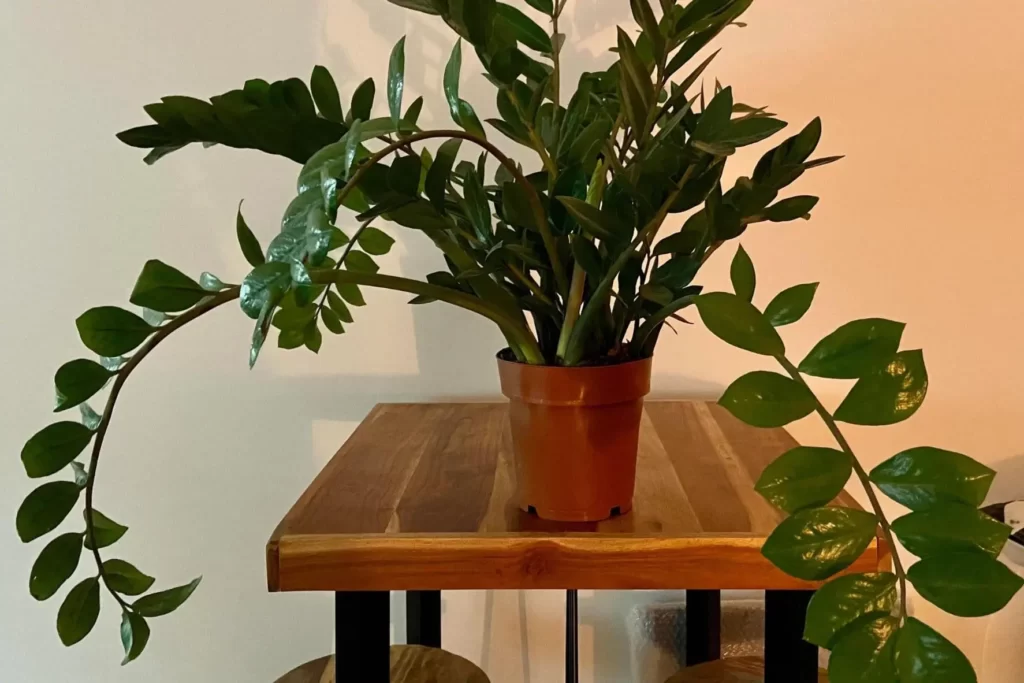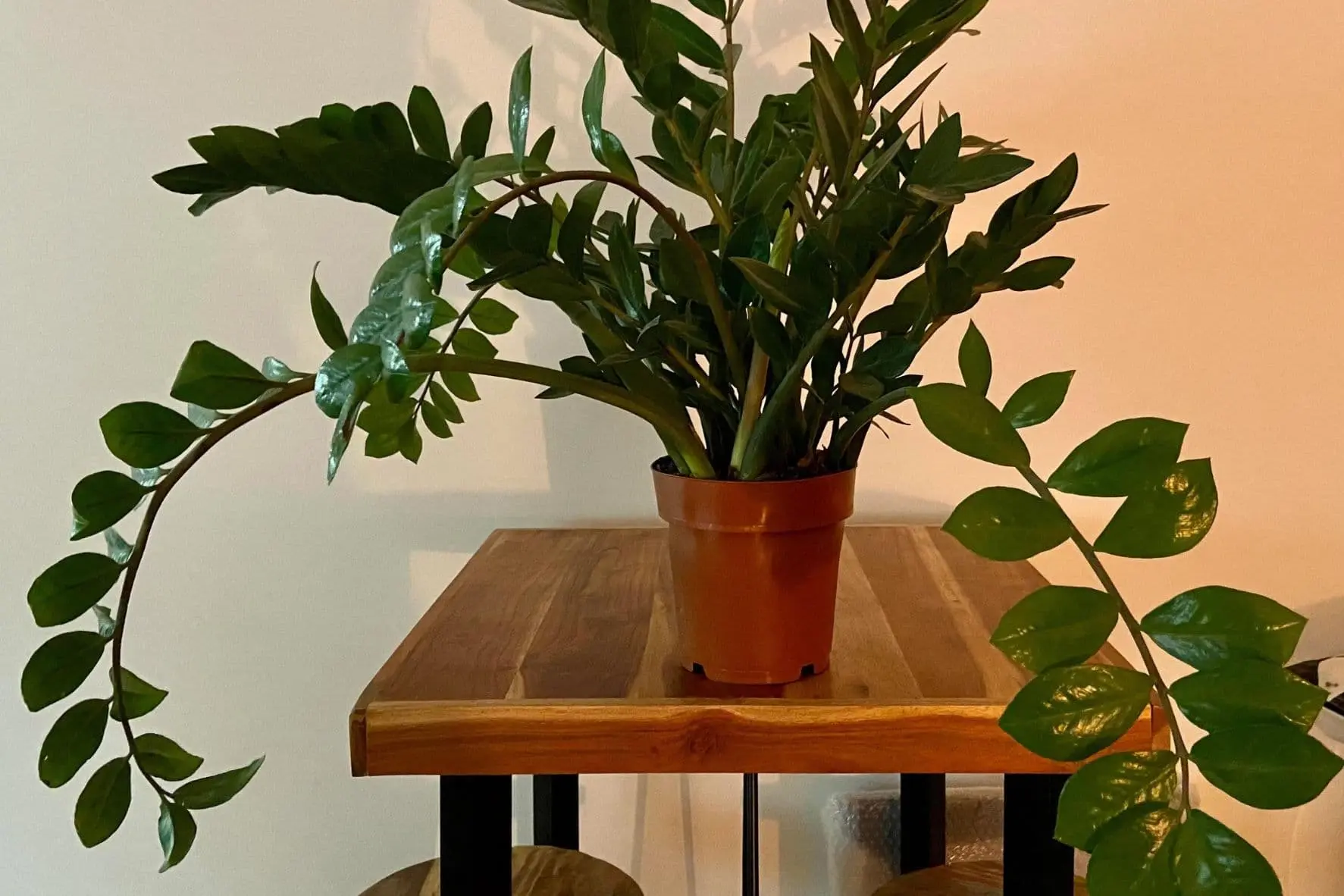The ZZ plant (Zamioculcas zamiifolia) is a popular choice among indoor plant enthusiasts due to its low maintenance and striking appearance.
However, one common issue that can cause concern for plant owners is the phenomenon of ZZ plant stalks falling over.
If you’ve noticed your ZZ plant’s stems drooping or collapsing, don’t fret!
In this blog post, we will delve into the various reasons behind this occurrence and explore effective solutions to revive and care for your ZZ plant.

Overwatering and Root Rot
One of the primary reasons for ZZ plant stalks falling over is overwatering. ZZ plants are well-adapted to surviving in drought-like conditions, so they prefer infrequent watering.
When the soil is constantly saturated, the plant’s roots can suffer from root rot, leading to weak stems and wilting.
Solution: To prevent overwatering and root rot, allow the top inch of the soil to dry out before watering your ZZ plant again. Ensure the pot has proper drainage to avoid waterlogging.
Underwatering and Dehydration
Ironically, underwatering can also cause ZZ plant stems to droop. While they are drought-tolerant, they still require occasional watering.
If your ZZ plant is left without water for prolonged periods, it will show signs of dehydration and limpness.
Solution: Establish a consistent watering schedule for your ZZ plant, but ensure the soil is well-draining.
Water the plant when the top 1-2 inches of the soil are dry to the touch. Avoid letting the plant sit in standing water, as this can lead to root rot.
Pot Size and Root Bound Conditions
As ZZ plants grow, they may become root-bound in their pots, meaning their root system outgrows the available space. This can lead to the plant becoming unstable and top-heavy, causing the stalks to fall over.
Solution: Regularly repot your ZZ plant every 1-2 years, preferably in the spring. Choose a slightly larger pot and fresh, well-draining potting mix to provide ample space for the roots to grow.
Lack of Adequate Light
Insufficient light is another factor that can cause ZZ plant stalks to weaken and droop. While they can tolerate low light conditions, they still require bright, indirect light for healthy growth.
Solution: Place your ZZ plant in a spot with bright, filtered sunlight. Avoid direct exposure to harsh, intense sunlight as it can scorch the leaves.
Pest Infestations
Pests, such as spider mites or mealybugs, can attack ZZ plants and damage their health. When left untreated, these pests can sap the plant’s energy, leading to weakened stalks.
Solution: Inspect your ZZ plant regularly for any signs of pest infestations. If you notice pests, isolate the plant from others to prevent spreading and treat it with appropriate insecticidal soap or neem oil.
Care Tips for ZZ Plants:
- Light Requirements: ZZ plants prefer bright, indirect light but can tolerate low light conditions. Place your ZZ plant near a window with filtered sunlight to ensure optimal growth. Avoid direct sunlight as it can scorch the leaves.
- Watering: ZZ plants are drought-tolerant and dislike soggy soil. Water your plant when the top 1-2 inches of the soil are dry to the touch. Ensure the pot has proper drainage to prevent overwatering and root rot.
- Potting and Repotting: Repot your ZZ plant every 1-2 years, preferably during the spring. Use a slightly larger pot with well-draining potting mix to provide ample space for the roots to grow.
- Temperature and Humidity: ZZ plants thrive in average room temperatures between 65°F to 75°F (18°C to 24°C). They can tolerate lower temperatures but are sensitive to frost. Normal indoor humidity levels are generally sufficient for ZZ plants.
- Fertilization: ZZ plants are not heavy feeders, and excessive fertilization can harm them. Use a balanced, diluted houseplant fertilizer once a month during the growing season (spring and summer). Avoid fertilizing during the dormant winter months.
- Pruning: Trim off yellow or damaged leaves using clean, sharp scissors. Regular pruning can help maintain the plant’s shape and remove any dead or unhealthy foliage.
- Pest Control: Inspect your ZZ plant regularly for signs of pests such as spider mites or mealybugs. If detected, treat the plant with insecticidal soap or neem oil following the manufacturer’s instructions.
- Dusting: ZZ plant leaves can accumulate dust, affecting their ability to photosynthesize. Wipe the leaves gently with a damp cloth to keep them clean and healthy.
- Pet Safety: ZZ plants contain calcium oxalate crystals, which can be toxic to pets if ingested. Keep the plant out of reach of curious animals and small children.
Conclusion
Understanding the reasons behind ZZ plant stalks falling over is crucial for ensuring the plant’s health and vitality.
By following the provided solutions and care tips, you can revive a drooping ZZ plant and prevent similar issues in the future.
Remember to strike the right balance with watering, provide adequate light, repot when necessary, and address pest issues promptly.
With proper care, your ZZ plant will reward you with its beautiful, glossy foliage and sturdy, upright stems, adding a touch of elegance to your indoor space.
Related FAQs:
Why are my ZZ plant stalks falling over?
ZZ plant stalks may fall over due to overwatering, underwatering, root rot, or lack of proper support. Additionally, being root-bound, insufficient light, and pest infestations can also weaken the stems.
How can I save my ZZ plant with drooping stalks?
To save your ZZ plant, first identify the cause of the drooping stalks (overwatering, underwatering, etc.). Adjust the watering schedule, repot if root-bound, provide adequate light, and address pest issues. Prune damaged leaves and ensure the plant has proper support to grow upright.
Can I propagate my ZZ plant from fallen stalks?
Yes, ZZ plants can be propagated from fallen stalks. Cut healthy, fallen stems into sections, and let them dry for a few hours. Then, plant them in a well-draining potting mix and keep them warm and lightly moist. New growth should appear within a few weeks.
How often should I water my ZZ plant to prevent stalks from falling over?
ZZ plants prefer infrequent watering. Water your ZZ plant when the top 1-2 inches of soil are dry to the touch. Avoid letting the plant sit in standing water, as this can lead to root rot and weaken the stalks.
My ZZ plant receives bright indirect light, but the stalks are still falling over. What should I do?
If your ZZ plant is getting enough light but still experiencing stalk drooping, check for other possible issues like overwatering, root-bound conditions, or pest infestations. Adjust your care routine accordingly to address the underlying cause.
How do I provide support to my ZZ plant stalks?
If your ZZ plant’s stalks are weak and falling over, use stakes or plant supports to prop them up. Gently tie the stalks to the support using soft ties or plant ties. This will help them grow upright and maintain their shape.
Can I use fertilizer to help my ZZ plant recover from falling stalks?
While fertilizer can be beneficial for overall plant health, avoid over-fertilizing ZZ plants. Use a balanced, diluted houseplant fertilizer once a month during the growing season (spring and summer). However, it’s essential to address the underlying issues causing stalk drooping before relying solely on fertilizers.
Is it normal for older ZZ plant stalks to droop over time?
Yes, it’s natural for older stalks of ZZ plants to droop and lose their rigidity over time. Regular pruning can help remove older, weaker stems and encourage new growth.
Can ZZ plants recover from severe stalk drooping?
ZZ plants are hardy and can recover from stalk drooping if the underlying issues are addressed promptly. With the right care and adjustments to the environment, they can grow new healthy stems and regain their upright posture.
Should I prune my ZZ plant if the stalks are falling over?
Yes, pruning can help rejuvenate your ZZ plant and encourage new growth. Trim away any damaged or drooping stalks using clean, sharp scissors or pruning shears. This will redirect the plant’s energy towards healthier stems and foliage.
Can ZZ plants recover from severe root rot causing stalk drooping?
ZZ plants can recover from root rot if the issue is caught early and addressed promptly. Trim away any rotted roots and repot the plant in fresh, well-draining soil. Adjust your watering schedule to prevent further waterlogging and allow the plant to recover.
My ZZ plant has been falling over despite proper care. What else could be causing it?
In addition to the common causes like overwatering and inadequate light, other factors such as temperature extremes, drafts, or sudden environmental changes can stress ZZ plants, causing them to droop. Ensure your plant is placed away from cold drafts, air conditioning vents, or heating sources.
Should I add support to my ZZ plant proactively, even if the stalks aren’t drooping yet?
Adding support to your ZZ plant preemptively can help prevent stalks from falling over, especially if you notice them becoming top-heavy. Staking or using plant supports can provide additional stability as the plant grows and matures.
Can ZZ plants recover from being root-bound?
Yes, ZZ plants can recover from being root-bound if they are repotted into a larger container with fresh soil. Gently tease out the roots and prune any excessively long or tangled roots before repotting. This will allow the plant to establish new growth and regain its vigor.
How long does it take for ZZ plant stalks to recover after falling over?
The recovery time for ZZ plant stalks can vary depending on the severity of the issue and how well it’s addressed. With proper care and environmental conditions, you can expect to see signs of recovery within a few weeks to a couple of months as new growth emerges.
Can I use a stake or support to train my ZZ plant to grow in a certain direction?
Yes, you can use stakes or supports to guide the growth of your ZZ plant in a desired direction. Secure the stems gently to the support using soft ties or plant ties, being careful not to constrict the growth. This can help create a more aesthetically pleasing shape for your plant.
My ZZ plant has developed yellowing leaves along with drooping stalks. What could be the issue?
Yellowing leaves on a ZZ plant can indicate various issues, including overwatering, underwatering, nutrient deficiencies, or pest infestations. Assess the plant’s watering schedule, soil moisture, and overall health to determine the underlying cause and take appropriate action.
Can ZZ plants tolerate being root-bound for an extended period?
While ZZ plants are known for their resilience and ability to thrive in less-than-ideal conditions, being root-bound for an extended period can eventually impact their health and growth. It’s best to repot ZZ plants every 1-2 years to prevent them from becoming too cramped in their containers.
Should I remove fallen or drooping stalks from my ZZ plant?
It’s generally advisable to remove fallen or severely drooping stalks from your ZZ plant, as they can detract from the plant’s appearance and may indicate underlying issues. Use clean, sharp scissors or pruning shears to trim away any damaged or weakened stems, promoting overall plant health.
Can ZZ plants recover from being exposed to cold temperatures?
ZZ plants are sensitive to cold temperatures and can suffer damage if exposed to prolonged cold drafts or temperatures below 50°F (10°C). While they may tolerate brief exposure to cooler conditions, prolonged cold stress can cause leaf yellowing, drooping, or even leaf drop. Move your ZZ plant to a warmer location away from drafts to encourage recovery.
My ZZ plant’s soil seems to dry out very quickly between waterings. Is this normal?
ZZ plants are known for their drought tolerance and ability to withstand periods of dry soil. However, excessively fast drying soil could indicate that the plant has outgrown its pot or that the potting mix is not retaining enough moisture. Consider repotting your ZZ plant into a slightly larger container with fresh, moisture-retentive soil to help maintain more consistent soil moisture levels.
Can ZZ plants be grown outdoors?
While ZZ plants are primarily grown as houseplants in most regions due to their sensitivity to cold temperatures, they can be grown outdoors in USDA hardiness zones 9-11 where temperatures remain consistently above 40°F (4°C) year-round. When grown outdoors, ZZ plants prefer partial shade and well-draining soil.

